Spectral Envelope Analysis of Subwavelength Grating Waveguide Micro Racetrack Ring Resonator for Cancer Sensing Using Integrated Photonics
Abstract
1. Introduction
2. Structure, Principle, and Design Methodology
3. Envelope Spectrum Formation and Surface Functionalization
4. Result and Discussion
5. Conclusions
Author Contributions
Funding
Institutional Review Board Statement
Informed Consent Statement
Data Availability Statement
Acknowledgments
Conflicts of Interest
References
- Shi, W.; Yun, H.; Lin, C.; Flueckiger, J.; Jaeger, N.A.F.; Chrostowski, L. Coupler-apodized Bragg-grating add–drop filter. Opt. Lett. 2013, 38, 3068. [Google Scholar] [CrossRef] [PubMed]
- Washburn, A.L.; Gunn, L.C.; Bailey, R.C. Label-Free Quantitation of a Cancer Biomarker in Complex Media Using Silicon Photonic Microring Resonators. Anal. Chem. 2009, 81, 9499–9506. [Google Scholar] [CrossRef] [PubMed]
- Reed, G.T.; Mashanovich, G.; Gardes, F.Y.; Thomson, D.J. Silicon optical modulators. Nat. Photonics 2010, 4, 518–526. [Google Scholar] [CrossRef]
- Singh, R.R.; Kumari, S.; Gautam, A.; Priye, V. Glucose Sensing Using Slot Waveguide-Based SOI Ring Resonator. IEEE J. Sel. Top. Quantum Electron. 2019, 25, 7300608. [Google Scholar] [CrossRef]
- Sajan, S.C.; Singh, A.; Sharma, P.K.; Kumar, S. Silicon Photonics Biosensors for Cancer Cells Detection—A Review. IEEE Sens. J. 2023, 23, 3366–3377. [Google Scholar] [CrossRef]
- Vardhan, S.; Gupta, N.K.; Kushwaha, A.; Verma, P.; Singh, R.R. Modelling of CO2 Gas Sensing using Spectral Envelope of SoI Integrated Racetrack Resonator. In JSAP-Optica Joint Symposia 2024 Abstracts; Optica Publishing Group: Washington, DC, USA, 2024; p. 17p_A25_4. [Google Scholar] [CrossRef]
- Vardhan, S.; Singh, R.R. Poynting Vector Analysis of SoI based Hybrid Plasmonic Rectangular Waveguide. In JSAP-Optica Joint Symposia 2022 Abstracts; Optica Publishing Group: Washington, DC, USA, 2022; p. 20p_C304_13. [Google Scholar]
- Scheler, O.; Kindt, J.T.; Qavi, A.J.; Kaplinski, L.; Glynn, B.; Barry, T.; Kurg, A.; Bailey, R.C. Label-free, multiplexed detection of bacterial tmRNA using silicon photonic microring resonators. Biosens. Bioelectron. 2012, 36, 56–61. [Google Scholar] [CrossRef]
- Shia, W.W.; Bailey, R.C. Single Domain Antibodies for the Detection of Ricin Using Silicon Photonic Microring Resonator Arrays. Anal. Chem. 2013, 85, 805–810. [Google Scholar] [CrossRef]
- Deen, M.J. Information and communications technologies for elderly ubiquitous healthcare in a smart home. Pers. Ubiquitous Comput. 2015, 19, 573–599. [Google Scholar] [CrossRef]
- Singh, R.R. Dispersion tailoring of silicon nanowire optical rectangular waveguide (SNORW). SN Appl. Sci. 2020, 2, 502. [Google Scholar] [CrossRef]
- Srivastava, D.; Vardhan, S.; Singh, R.R. SoI Based Optical 1 × 2 Wavelength Independent 3-dB Power Splitter Design Using Three Rectangular Cross-Sectional Cuboidal Waveguides. Silicon 2023, 15, 1381–1391. [Google Scholar] [CrossRef]
- Talebi Fard, S.; Grist, S.M.; Donzella, V.; Schmidt, S.A.; Flueckiger, J.; Wang, X.; Shi, W.; Millspaugh, A.; Webb, M.; Ratner, D.M.; et al. Label-Free Silicon Photonic Biosensors for Use in Clinical Diagnostics; Kubby, J., Reed, G.T., Eds.; SPIE: Bellingham, WA, USA, 2013; p. 862909. [Google Scholar]
- Densmore, A.; Vachon, M.; Xu, D.-X.; Janz, S.; Ma, R.; Li, Y.-H.; Lopinski, G.; Delâge, A.; Lapointe, J.; Luebbert, C.C.; et al. Silicon photonic wire biosensor array for multiplexed real-time and label-free molecular detection. Opt. Lett. 2009, 34, 3598. [Google Scholar] [CrossRef] [PubMed]
- Iqbal, M.; Gleeson, M.A.; Spaugh, B.; Tybor, F.; Gunn, W.G.; Hochberg, M.; Baehr-Jones, T.; Bailey, R.C.; Gunn, L.C. Label-Free Biosensor Arrays Based on Silicon Ring Resonators and High-Speed Optical Scanning Instrumentation. IEEE J. Sel. Top. Quantum Electron. 2010, 16, 654–661. [Google Scholar] [CrossRef]
- Luchansky, M.S.; Washburn, A.L.; Martin, T.A.; Iqbal, M.; Gunn, L.C.; Bailey, R.C. Characterization of the evanescent field profile and bound mass sensitivity of a label-free silicon photonic microring resonator biosensing platform. Biosens. Bioelectron. 2010, 26, 1283–1291. [Google Scholar] [CrossRef] [PubMed]
- Vardhan, S.; Singh, R.R. Design, simulation and performance comparison of SoI rectangular waveguide and SMF for methane detection. In Proceedings of the Integrated Photonics Platforms II; Baets, R.G., O’Brien, P., Vivien, L., Eds.; SPIE: Bellingham, WA, USA, 2022; p. 32. [Google Scholar]
- Fard, S.T.; Donzella, V.; Schmidt, S.A.; Flueckiger, J.; Grist, S.M.; Talebi Fard, P.; Wu, Y.; Bojko, R.J.; Kwok, E.; Jaeger, N.A.F.; et al. Performance of ultra-thin SOI-based resonators for sensing applications. Opt. Express 2014, 22, 14166. [Google Scholar] [CrossRef]
- Dwivedi, R.; Kumar, A. Refractive index sensing using silicon-on-insulator waveguide based modal interferometer. Optik 2018, 156, 961–967. [Google Scholar] [CrossRef]
- Xu, Q.; Almeida, V.R.; Panepucci, R.R.; Lipson, M. Experimental demonstration of guiding and confining light in nanometer-size low-refractive-index material. Opt. Lett. 2004, 29, 1626. [Google Scholar] [CrossRef]
- Vardhan, S.; Singh, R.R. Optimization and Comparative Analysis of Rectangular and Slot Waveguide based Symmetric Ring and Racetrack Resonators for SoI Photonic Integrated Filters. Silicon 2024, 16, 2913–2926. [Google Scholar] [CrossRef]
- Yalcin, A.; Popat, K.; Aldridge, J.; Desai, T.; Hryniewicz, J.; Chbouki, N.; Little, B.; King, O.; Van, V.; Chu, S.; et al. Optical sensing of biomolecules using microring resonators. IEEE J. Sel. Top. Quantum Electron. 2006, 12, 148–155. [Google Scholar] [CrossRef]
- Ciminelli, C.; Dell’olio, F.; Conteduca, D.; Campanella, C.; Armenise, M. High performance SOI microring resonator for biochemical sensing. Opt. Laser Technol. 2014, 59, 60–67. [Google Scholar] [CrossRef]
- Jin, L.; Li, M.; He, J.-J. Analysis of Wavelength and Intensity Interrogation Methods in Cascaded Double-Ring Sensors. J. Light. Technol. 2012, 30, 1994–2002. [Google Scholar] [CrossRef]
- Stelzle, D.; Tanaka, L.F.; Lee, K.K.; Ibrahim Khalil, A.; Baussano, I.; Shah, A.S.V.; McAllister, D.A.; Gottlieb, S.L.; Klug, S.J.; Winkler, A.S.; et al. Estimates of the global burden of cervical cancer associated with HIV. Lancet Glob. Health 2021, 9, e161–e169. [Google Scholar] [CrossRef] [PubMed]
- Monica; Mishra, R. An epidemiological study of cervical and breast screening in India: District-level analysis. BMC Womens. Health 2020, 20, 225. [Google Scholar] [CrossRef]
- Mathur, P.; Sathishkumar, K.; Chaturvedi, M.; Das, P.; Sudarshan, K.L.; Santhappan, S.; Nallasamy, V.; John, A.; Narasimhan, S.; Roselind, F.S. Cancer Statistics, 2020: Report from National Cancer Registry Programme, India. JCO Glob. Oncol. 2020, 6, 1063–1075. [Google Scholar] [CrossRef] [PubMed]
- El-Shenawee, M.; Vohra, N.; Bowman, T.; Bailey, K. Cancer detection in excised breast tumors using terahertz imaging and spectroscopy. Biomed. Spectrosc. Imaging 2019, 8, 1–9. [Google Scholar] [CrossRef] [PubMed]
- George, S.; Chaudhery, V.; Lu, M.; Takagi, M.; Amro, N.; Pokhriyal, A.; Tan, Y.; Ferreira, P.; Cunningham, B.T. Sensitive detection of protein and miRNA cancer biomarkers using silicon-based photonic crystals and a resonance coupling laser scanning platform. Lab Chip 2013, 13, 4053. [Google Scholar] [CrossRef]
- Washburn, A.L.; Shia, W.W.; Lenkeit, K.A.; Lee, S.-H.; Bailey, R.C. Multiplexed cancer biomarker detection using chip-integrated silicon photonic sensor arrays. Analyst 2016, 141, 5358–5365. [Google Scholar] [CrossRef]
- Ali, L.; Mohammed, M.U.; Khan, M.; Bin Yousuf, A.H.; Chowdhury, M.H. High-Quality Optical Ring Resonator-Based Biosensor for Cancer Detection. IEEE Sens. J. 2020, 20, 1867–1875. [Google Scholar] [CrossRef]
- Jokar, M.H.; Naraghi, A.; Seifouri, M.; Olyaee, S. Photonic crystal bio-sensor for highly sensitive label-free detection of cancer cells. Opt. Quantum Electron. 2023, 55, 660. [Google Scholar] [CrossRef]
- Han, Y.; Yan, Z.; Ng, W.K.; Xue, Y.; Wong, K.S.; Lau, K.M. Bufferless 15 µm III-V lasers grown on Si-photonics 220 nm silicon-on-insulator platforms. Optica 2020, 7, 148. [Google Scholar] [CrossRef]
- Agrawal, G.P. Fiber-Optic Communication Systems, 4th ed.; Wiley-Blackwell: Oxford, UK, 2010. [Google Scholar]
- An, L.; Liu, H.; Sun, Q.; Huang, N.; Wang, Z. Wavelength conversion in highly nonlinear silicon–organic hybrid slot waveguides. Appl. Opt. 2014, 53, 4886. [Google Scholar] [CrossRef]
- Vardhan, S.; Singh, R.R. Analytical Investigation of DNA Hybridization Sensing Using Integrated Photonic Micro-Ring Resonators. Photonics 2025, 12, 216. [Google Scholar] [CrossRef]
- Mishra, G.P.; Kumar, D.; Chaudhary, V.S.; Murmu, G. Cancer cell detection by a heart-shaped dual-core photonic crystal fiber sensor. Appl. Opt. 2020, 59, 10321. [Google Scholar] [CrossRef]
- Jabin, M.A.; Ahmed, K.; Rana, M.J.; Paul, B.K.; Islam, M.; Vigneswaran, D.; Uddin, M.S. Surface Plasmon Resonance Based Titanium Coated Biosensor for Cancer Cell Detection. IEEE Photonics J. 2019, 11, 3700110. [Google Scholar] [CrossRef]
- Xu, Y.; Fu, C.; Sun, S.; Kong, M. Wide-range refractive index sensing relied on tracking the envelope spectrum of a dispersive subwavelength grating microring resonator. Opt. Laser Technol. 2022, 154, 108304. [Google Scholar] [CrossRef]
- Steglich, P.; Rabus, D.G.; Sada, C.; Paul, M.; Weller, M.G.; Mai, C.; Mai, A. Silicon Photonic Micro-Ring Resonators for Chemical and Biological Sensing: A Tutorial. IEEE Sens. J. 2022, 22, 10089–10105. [Google Scholar] [CrossRef]
- Gaur, G.; Hu, S.; Mernaugh, R.L.; Kravchenko, I.I.; Retterer, S.T.; Weiss, S.M. Label-free detection of Herceptin® using suspended silicon microring resonators. Sens. Actuators B Chem. 2018, 275, 394–401. [Google Scholar] [CrossRef]
- Guarisco, M.; Gandolfi, D.; Guider, R.; Vanzetti, L.; Bartali, R.; Ghulinyan, M.; Cretich, M.; Chiari, M.; Bettotti, P.; Pavesi, L.; et al. A new aptamer immobilization strategy for protein recognition. Sens. Actuators B Chem. 2017, 252, 222–231. [Google Scholar] [CrossRef]
- Wong, A.K.Y.; Krull, U.J. Surface characterization of 3-glycidoxypropyltrimethoxysilane films on silicon-based substrates. Anal. Bioanal. Chem. 2005, 383, 187–200. [Google Scholar] [CrossRef]
- Antoniou, M.; Tsounidi, D.; Petrou, P.S.; Beltsios, K.G.; Kakabakos, S.E. Functionalization of silicon dioxide and silicon nitride surfaces with aminosilanes for optical biosensing applications. Med. Devices Sens. 2020, 3, e10072. [Google Scholar] [CrossRef]
- Komikawa, T.; Tanaka, M.; Yanai, K.; Johnson, B.R.G.; Critchley, K.; Onodera, T.; Evans, S.D.; Toko, K.; Okochi, M. A bioinspired peptide matrix for the detection of 2,4,6-trinitrotoluene (TNT). Biosens. Bioelectron. 2020, 153, 112030. [Google Scholar] [CrossRef]
- Gajos, K.; Szafraniec, K.; Petrou, P.; Budkowski, A. Surface density dependent orientation and immunological recognition of antibody on silicon: TOF-SIMS and surface analysis of two covalent immobilization methods. Appl. Surf. Sci. 2020, 518, 146269. [Google Scholar] [CrossRef]
- Park, M.K.; Kee, J.S.; Quah, J.Y.; Netto, V.; Song, J.; Fang, Q.; La Fosse, E.M.; Lo, G.-Q. Label-free aptamer sensor based on silicon microring resonators. Sens. Actuators B Chem. 2013, 176, 552–559. [Google Scholar] [CrossRef]
- Bañuls, M.-J.; Puchades, R.; Maquieira, Á. Chemical surface modifications for the development of silicon-based label-free integrated optical (IO) biosensors: A review. Anal. Chim. Acta 2013, 777, 1–16. [Google Scholar] [CrossRef] [PubMed]
- Ahmed, R.; Rifat, A.A.; Yetisen, A.K.; Salem, M.S.; Yun, S.-H.; Butt, H. Optical microring resonator based corrosion sensing. RSC Adv. 2016, 6, 56127–56133. [Google Scholar] [CrossRef]
- Azuelos, P.; Girault, P.; Lorrain, N.; Dumeige, Y.; Bodiou, L.; Poffo, L.; Guendouz, M.; Thual, M.; Charrier, J. Optimization of porous silicon waveguide design for micro-ring resonator sensing applications. J. Opt. 2018, 20, 085301. [Google Scholar] [CrossRef]
- Tu, Z.; Gao, D.; Zhang, M.; Zhang, D. High-sensitivity complex refractive index sensing based on Fano resonance in the subwavelength grating waveguide micro-ring resonator. Opt. Express 2017, 25, 20911. [Google Scholar] [CrossRef]
- Shi, B.; Chen, X.; Cai, Y.; Zhang, S.; Wang, T.; Wang, Y. Compact Slot Microring Resonator for Sensitive and Label-Free Optical Sensing. Sensors 2022, 22, 6467. [Google Scholar] [CrossRef]
- Flueckiger, J.; Schmidt, S.; Donzella, V.; Sherwali, A.; Ratner, D.M.; Chrostowski, L.; Cheung, K.C. Sub-wavelength grating for enhanced ring resonator biosensor. Opt. Express 2016, 24, 15672. [Google Scholar] [CrossRef]
- Butt, M.A.; Khonina, S.N.; Kazanskiy, N.L. A highly sensitive design of subwavelength grating double-slot waveguide microring resonator. Laser Phys. Lett. 2020, 17, 076201. [Google Scholar] [CrossRef]
- Sun, S.; Xiong, X.; Liang, J.; Xu, Y.; Shen, L. Envelope Spectrum of the Subwavelength Grating Slot Waveguide Microring Resonator for High-sensitivity and Wide-range Refractive Index Sensing Applications. J. Light. Technol. 2024, 42, 5390–5398. [Google Scholar] [CrossRef]
- Sun, S.; Chang, M.; Kong, M.; Xu, Y. Two-peak envelope spectrum of a subwavelength grating microring resonator for wide-range and high-sensitivity refractive index sensing. Photonics Nanostructures Fundam. Appl. 2024, 60, 101273. [Google Scholar] [CrossRef]
- Chowdhury, A.A.; Khan, M.R.H.; Islam, M.R.; Iftekher, A.N.M.; Hosen, M.S.; Mim, M.H.; Nishat, M.M. Gold nanowire-infused square-clad SPR-PCF biosensor for detection of various cancer cells. Sens. Bio-Sens. Res. 2024, 45, 100670. [Google Scholar] [CrossRef]
- Khani, S.; Hayati, M. Optical biosensors using plasmonic and photonic crystal band-gap structures for the detection of basal cell cancer. Sci. Rep. 2022, 12, 5246. [Google Scholar] [CrossRef]
- Kaur, B.; Kumar, S.; Kaushik, B.K. MXenes-Based Fiber-Optic SPR Sensor for Colorectal Cancer Diagnosis. IEEE Sens. J. 2022, 22, 6661–6668. [Google Scholar] [CrossRef]
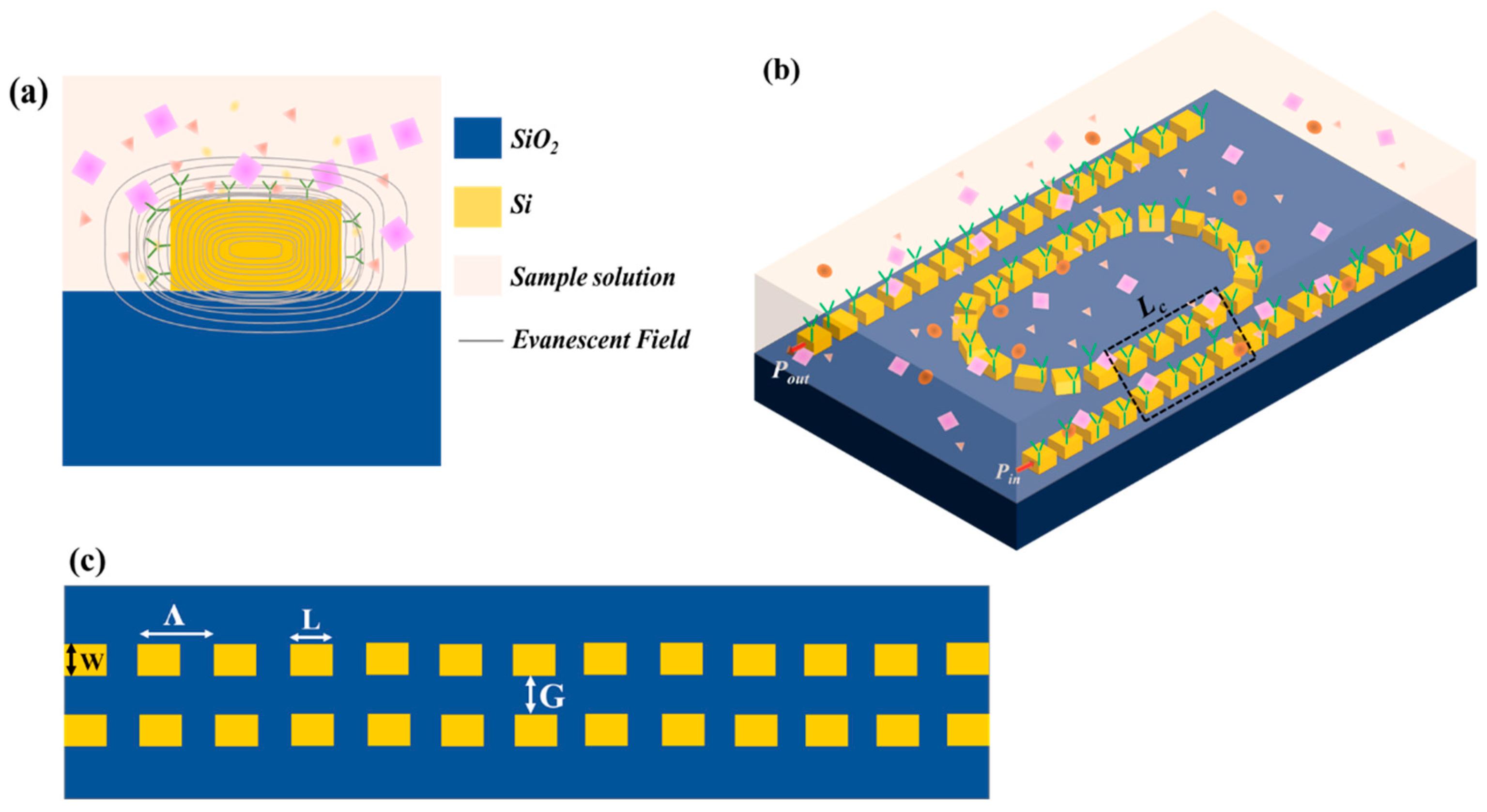
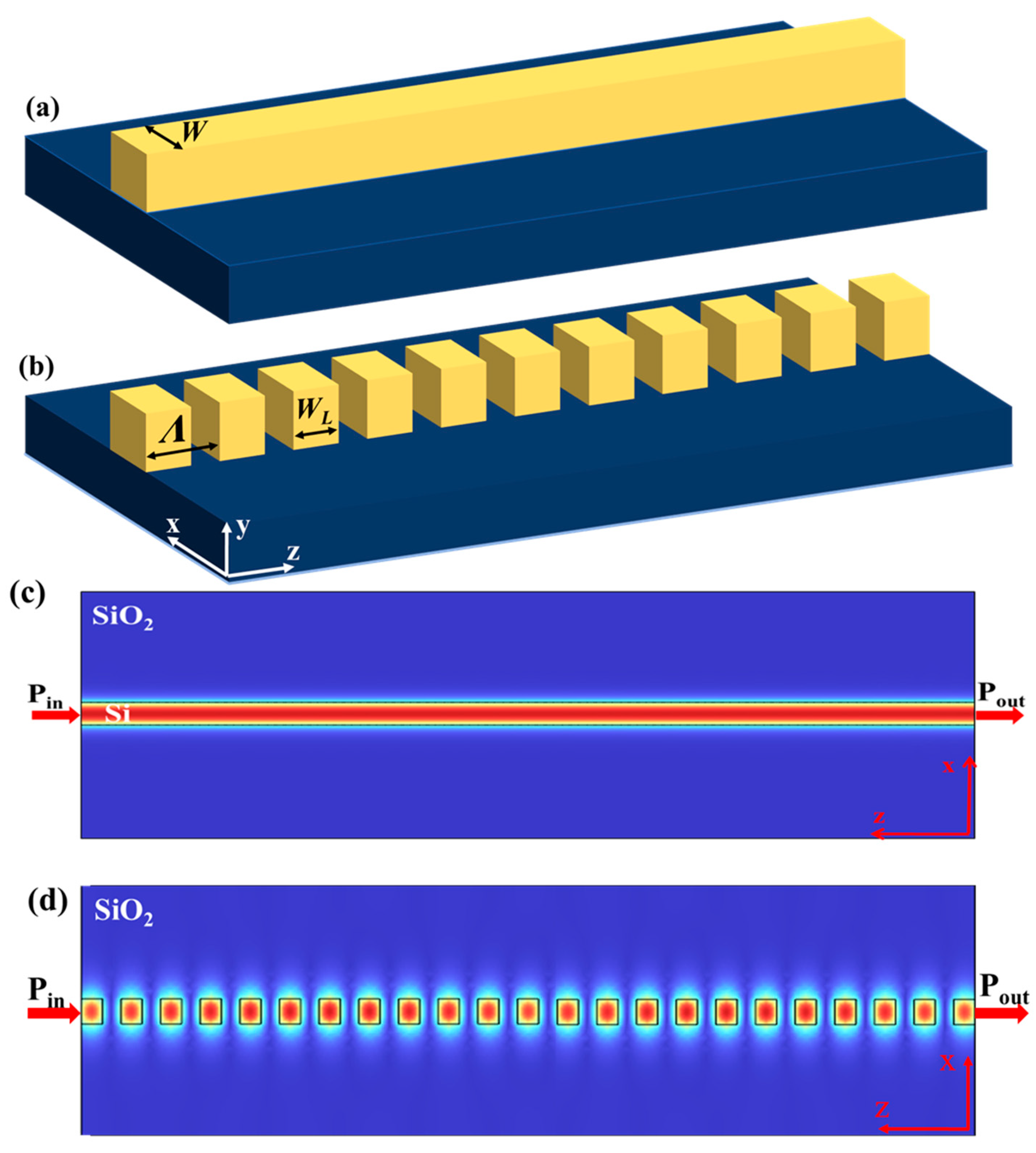

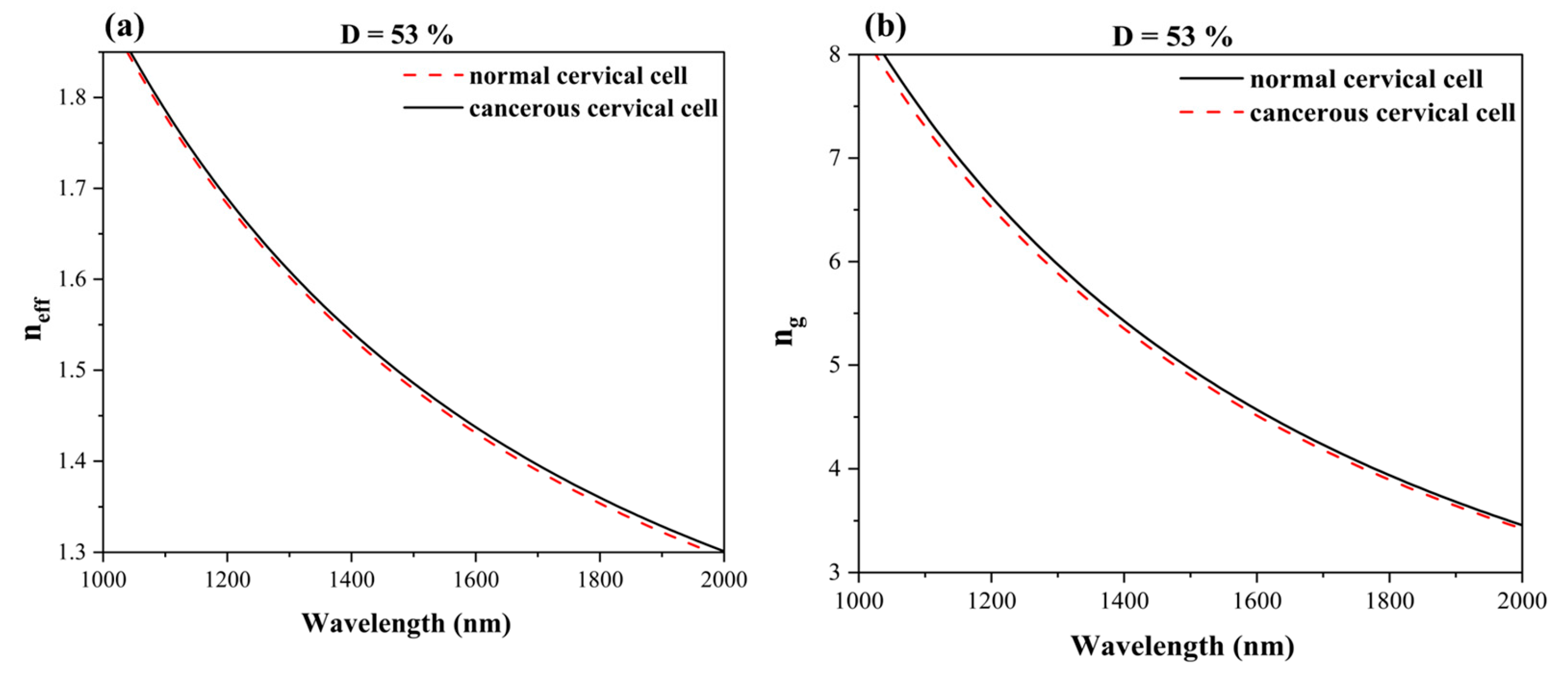


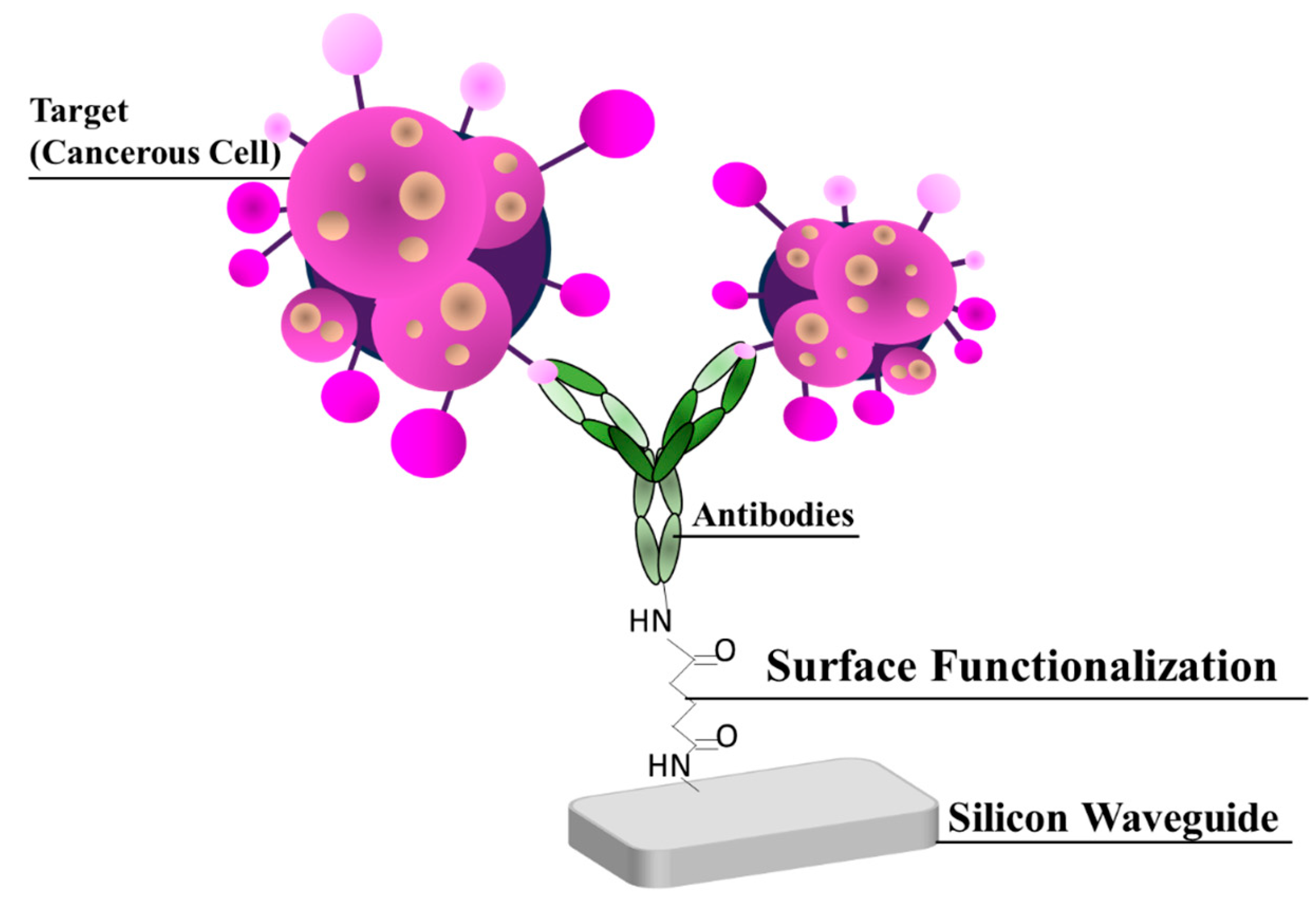

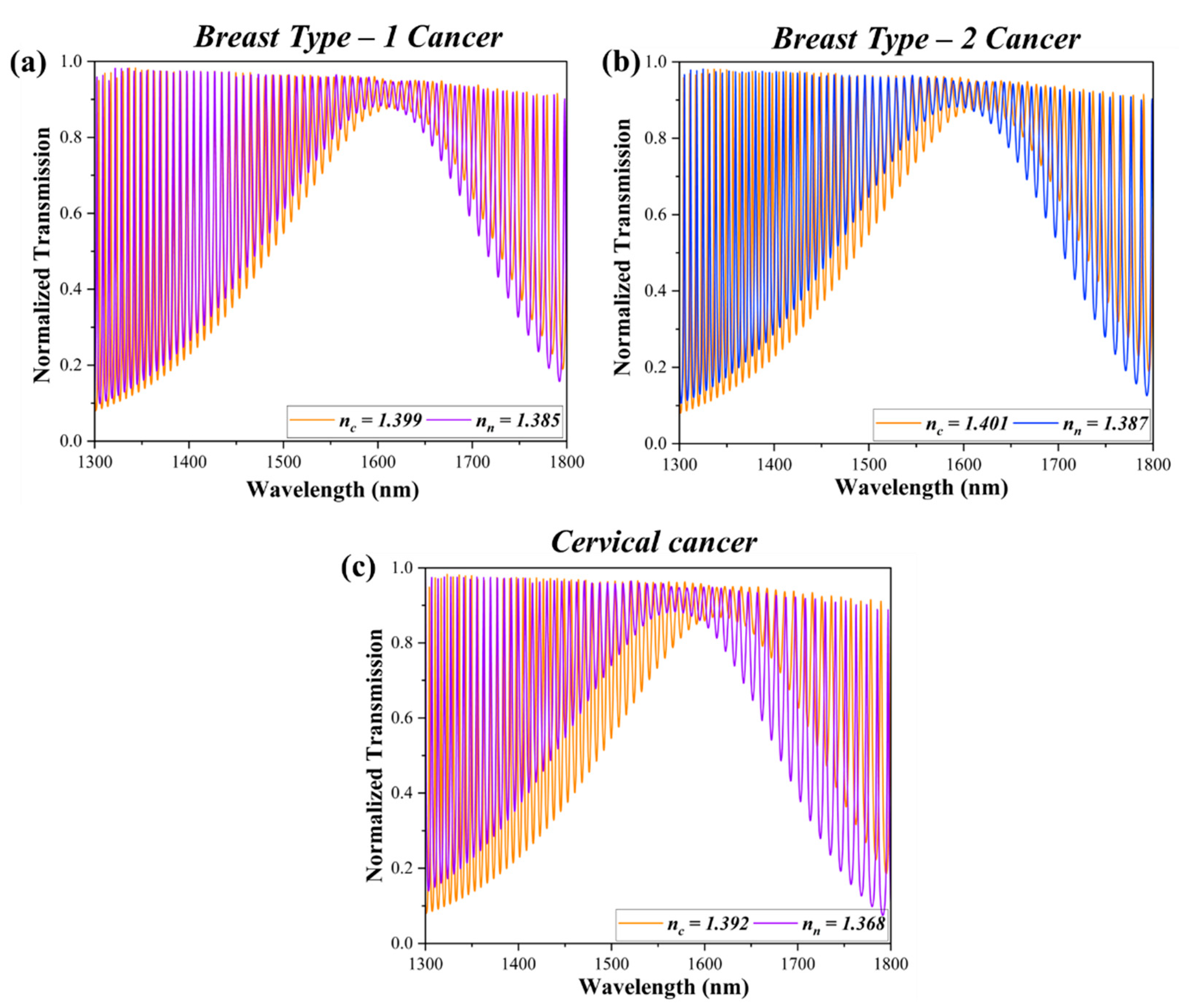
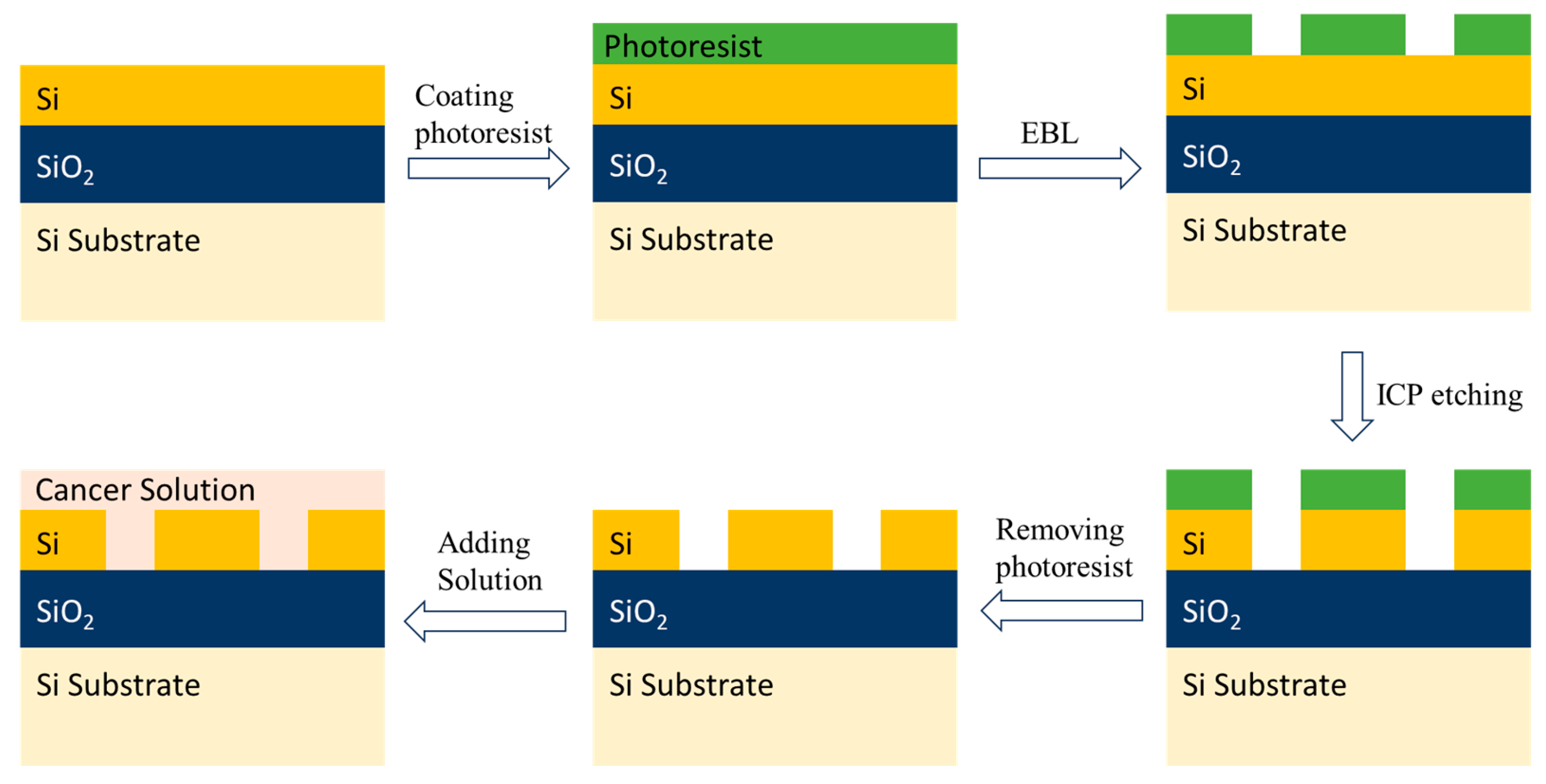
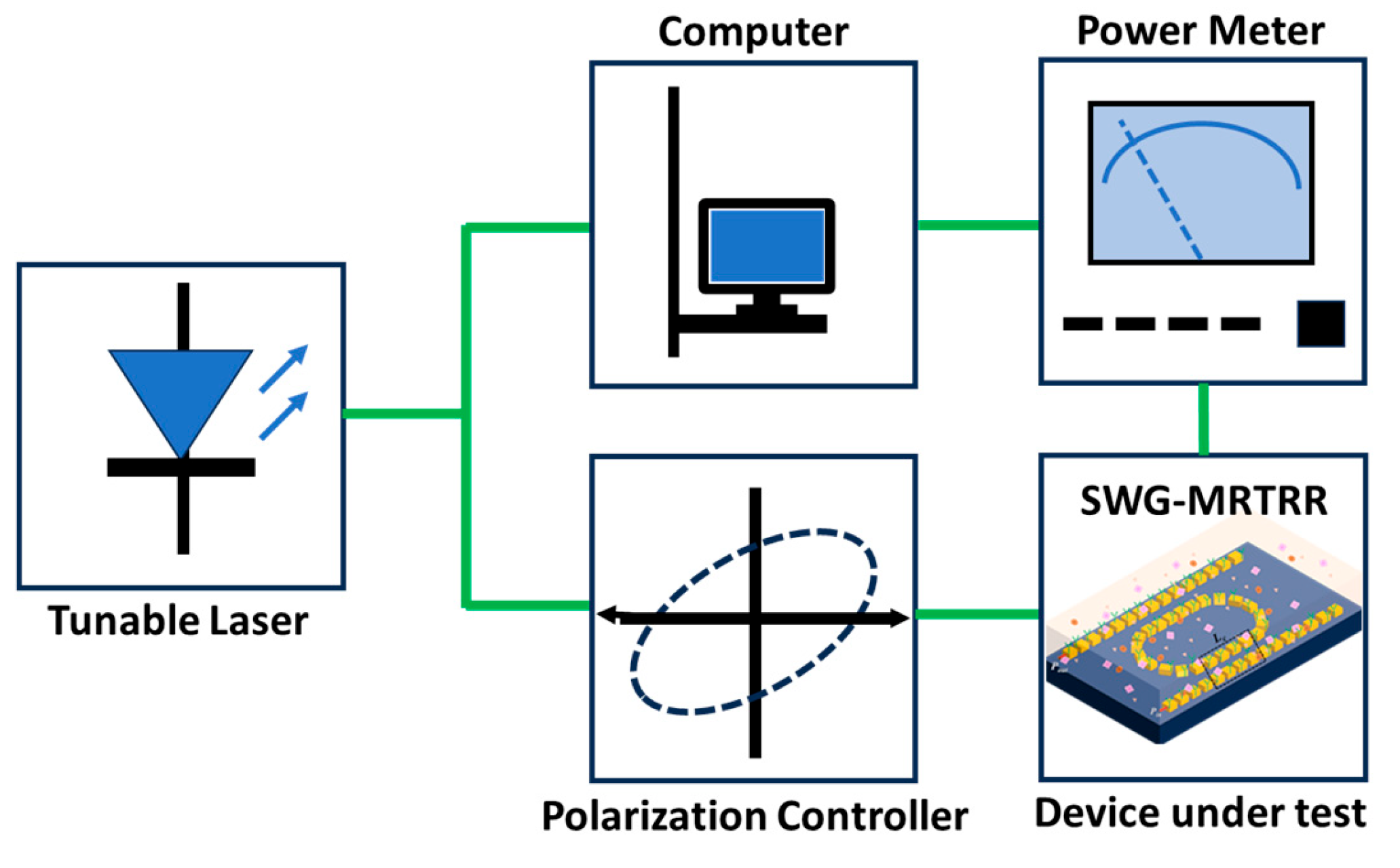
| S. No. | Cell Type | Cell Condition | Refractive Index |
|---|---|---|---|
| 1 | Cervical | Normal | 1.368 |
| Cancerous | 1.392 | ||
| 2 | Breast Type-1 | Normal | 1.385 |
| Cancerous | 1.399 | ||
| 3 | Breast Type-2 | Normal | 1.387 |
| Cancerous | 1.401 |
| Type of Cancer | Waveguide Type | Γ (%) in Si | Γ (%) in SiO2 | Γ (%) in Cladding |
|---|---|---|---|---|
| Breast Type-I for normal cell | Rectangular Waveguide | 89.62 | 4.28 | 6.1 |
| SWG Waveguide | 41.99 | 14.39 | 43.62 | |
| Breast Type-I for cancerous cell | Rectangular Waveguide | 89.95 | 4.7 | 5.35 |
| SWG Waveguide | 42.12 | 14.14 | 42.11 | |
| Breast Type-II for normal cell | Rectangular Waveguide | 90.61 | 4.93 | 4.46 |
| SWG Waveguide | 42.07 | 14.23 | 43.69 | |
| Breast Type-II for cancerous cell | Rectangular Waveguide | 89.88 | 4.91 | 5.21 |
| SWG Waveguide | 42.16 | 14.05 | 43.78 | |
| Cervical Cancer for normal cell | Rectangular Waveguide | 89.65 | 4.96 | 5.39 |
| SWG Waveguide | 42.08 | 14.21 | 43.69 | |
| Cervical Cancer for cancerous cell | Rectangular Waveguide | 89.9 | 4.92 | 5.18 |
| SWG Waveguide | 42.17 | 14.02 | 43.82 |
| Type | S (nm/RIU) | Q-Factor | iLoD (RIU) |
|---|---|---|---|
| Cervical | 1825 | 269.68 | 3.28 × 10−3 |
| Breast Type-1 | 1705.14 | 280.78 | 3.37 × 10−3 |
| Breast Type-2 | 1004.71 | 315.76 | 5.09 × 10−3 |
| (a) | ||||||
|---|---|---|---|---|---|---|
| Structure Type | Transmittance Spectrum Type | S (nm/RIU) | Q-Factor | iLoD (RIU) | FSR (nm) | Ref. |
| Ring resonator | One resonance | 517 | 187.61 | - | 40 | [49] |
| Racetrack resonator | 800 | - | 1.2 × 10−4 | - | [50] | |
| SWG ring resonator | 366 | - | 5.46 × 10−5 | - | [51] | |
| Slot ring resonator | 403 | - | 0.129 | - | [52] | |
| SWG ring resonator | 490 | 7000 | 2 × 10−6 | - | [53] | |
| SWG single-slot ring resonator | 340 | 4858 | 7.35 × 10−4 | - | [54] | |
| SWG double-slot ring resonator | 440 | 2253.8 | 1.23 × 10−3 | - | [54] | |
| SWG slot racetrack resonator | Envelope | 1420 | 905 | 1.2 × 10−3 | FSR free | [55] |
| SWG ring resonator | 600 | - | - | [39] | ||
| SWG ring resonator | 444 | - | - | [56] | ||
| SWG MRTRR | 1825, 1705.14, 1004.71 | 269.68, 280.78, 315.76 | 3.28 × 10−3, 3.37 × 10−3, 5.09 × 10−3 | Present work | ||
| (b) | ||||||
| Cancer Type | Structure Type | S (nm/RIU) | Ref. | |||
| Skin Cancer, Cervical Cancer, Blood Cancer, Adrenal Gland Cancer, Breast Type-1 Cancer, and Breast Type-2 Cancer | SPR PCF | 6500, 14,583.33, 16,428.57, 25,714.28, 32,857.14, 35,714.28 | [57] | |||
| Basal Cell cancer | PC and plasmonic | 954, 952.4 | [58] | |||
| Colorectal Cancer | MXene-based fiber optic sensor | 107, 66.28 | [59] | |||
| Cervical Cancer, Breast Type-1, and Breast Type-2 Cancer | SWG MRTRR | 1825, 1705.14, 1004.71 | Present work | |||
Disclaimer/Publisher’s Note: The statements, opinions and data contained in all publications are solely those of the individual author(s) and contributor(s) and not of MDPI and/or the editor(s). MDPI and/or the editor(s) disclaim responsibility for any injury to people or property resulting from any ideas, methods, instructions or products referred to in the content. |
© 2025 by the authors. Licensee MDPI, Basel, Switzerland. This article is an open access article distributed under the terms and conditions of the Creative Commons Attribution (CC BY) license (https://creativecommons.org/licenses/by/4.0/).
Share and Cite
Vardhan, S.; Srivastava, D.; Gupta, N.K.; Singh, R.R.; Kumar, S. Spectral Envelope Analysis of Subwavelength Grating Waveguide Micro Racetrack Ring Resonator for Cancer Sensing Using Integrated Photonics. Photonics 2025, 12, 376. https://doi.org/10.3390/photonics12040376
Vardhan S, Srivastava D, Gupta NK, Singh RR, Kumar S. Spectral Envelope Analysis of Subwavelength Grating Waveguide Micro Racetrack Ring Resonator for Cancer Sensing Using Integrated Photonics. Photonics. 2025; 12(4):376. https://doi.org/10.3390/photonics12040376
Chicago/Turabian StyleVardhan, Shalini, Devansh Srivastava, Naveen Kumar Gupta, Ritu Raj Singh, and Santosh Kumar. 2025. "Spectral Envelope Analysis of Subwavelength Grating Waveguide Micro Racetrack Ring Resonator for Cancer Sensing Using Integrated Photonics" Photonics 12, no. 4: 376. https://doi.org/10.3390/photonics12040376
APA StyleVardhan, S., Srivastava, D., Gupta, N. K., Singh, R. R., & Kumar, S. (2025). Spectral Envelope Analysis of Subwavelength Grating Waveguide Micro Racetrack Ring Resonator for Cancer Sensing Using Integrated Photonics. Photonics, 12(4), 376. https://doi.org/10.3390/photonics12040376






